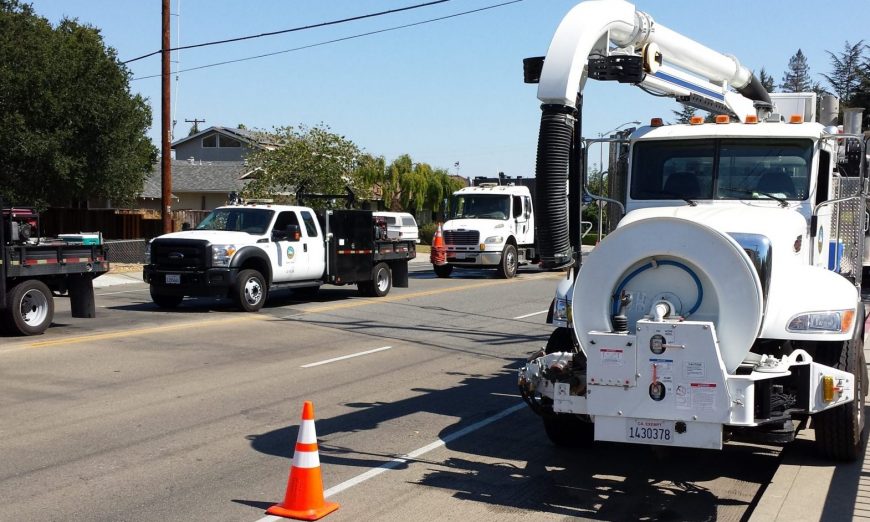Santa Clara is beefing up its efforts in the global fight against fatbergs. Against what?
Fatbergs are composed of fats, oils and grease (FOG) that drain down the pipes from kitchen sinks and into the sewers. The grease congeals around items such as wet wipes (one of the worst offenders), dental floss, tampons and diapers flushed down toilets.
The yucky globs harden like concrete in the cold underground sewer pipes. The fatbergs clog sewers and waste station processing equipment, causing sewage spills that are costly to fix and hazardous to public health and the environment.
Santa Clara is raising awareness of the issue through its Fats, Oils and Grease (FOG) program. The program involves educating residents about the importance of keeping FOG from going down drains and clogging pipes and sewers that then overflow, spilling untreated sewage into San Francisco Bay.
The mother of all fatbergs (a word coined by London sewer workers) was discovered blocking London sewers in September of 2017. It was one block long, measuring 850 feet—about the length of two football fields. It weighed an estimated 140 tons, and it took nine weeks to dislodge it, using jet hoses, pickaxes and shovels. Yuck.
A chunk of the fatberg (the world’s largest so far) is the star attraction of a new exhibit at the Museum of London.
“A fatberg has long been on the Museum of London wish list. We want to reflect the highs and lows of city living,” curator Vyki Sparkes told the “Washington Post,” adding that fatbergs are “gross, but strangely compelling.”
Closer to home, also in September of 2017, Baltimore, MD, had its own fatberg to contend with. The 12-square-foot fatberg caked the walls of a 24-inch diameter, 100-year-old pipe, blocking as much as 85 percent of the pipe. It caused an overflow of 1.2 million gallons of sewage into a river.
In New York City’s 2016 “State of the Sewers” report, grease is cited as causing 71 percent of sewer backups. The city spent $18 million over five years fighting fatbergs. San Francisco Public Utilities Commission says that it spends $3.5 million each year clearing grease-clogged pipes. Grease collected from its restaurants is being converted to biofuel.
Then there’s Santa Clara
Gary Welling, Acting Director of Water & Sewer Utilities, said that Santa Clara’s 280 miles of sewer collection pipes range from zero to 92 years old—35 percent are zero to 50 years old, 60 percent are 50 to 70 years old, and the rest from 68 to 92 years old.
“Our staff are very proactive. They assess and clean the sewer pipes on a daily basis, checking about three miles of pipes a month,” said Welling. “The yearly number of sanitary sewer overflows is very small.”
Welling explained that a camera is used to locate leaks and defects in the pipes. If grease is spotted coming out of a connection, it can be traced to its source. Santa Clara has about 630 food service establishments—the biggest users of oil—to inspect on a rotating basis to make sure their FOG disposal systems are up to code.
“As an individual, you can make a difference in reducing sewer overflows,” said Welling. “By implementing simple best management practices, you can do your part. It’s in everyone’s best interest. Ultimately, it’s protecting the Bay because everything flows to the Bay.”
Best Management Practices
To prevent FOG problems, never pour fats, oil or grease down a drain. Instead, pour it into a disposable container and put it in the trash. Wipe grease from pans with a paper towel. And this may be a surprise, don’t use your garbage disposal. Put garbage in your collection bin.
The FOG Control Program is mandated by the U.S. EPA and the state of California as part of required city Sewer System Management Plans. Effective July 1, 2017, the responsibility for managing the city’s FOG program was shifted to Santa Clara from San Jose’s Regional Wastewater Facility, where football-sized fatbergs have ended up.
Santa Clara is hiring a new code enforcement officer, who will be assisted by the existing staff of 22 in sewer operations and administration. The $170,000 a year previously paid to San Jose to operate the FOG program, will now stay with Santa Clara to cover program costs.
Visit the city’s new FOG site at www.santaclaraca.gov/FOG or call (408) 615-2000 for details on preventing costly plumbing and sewer backups.







Medicare should retrofit toilets with fifty buck automatic bidets. Old folks can’t stand up to do a normal wipe so they or their aides use wipes. And the yuppies wipe the hinds of their dogs and cats. And the super soft toilet papers are just as bad, you can make a quilt with some of them. Drill sargent rubbed my skid marks in my face. You need to mandate passive macerators before homes dump into the sewers. Or supply shards of metal and glass to do the maceration. Quest’s Golobic showed beards have fecal matter spread during bathing. And hemorhoidal mucous leakage causes urinary infections. They need to use catheters that pump water into the gizzard while pumping feces out. Garlic eaters tend to leave messy toilet seats which is why food service workers should be mndated to use bidets. Elvis died of megacolon parsesis from tricyclic antidepressants, which is why Jaanese love him so much and claim to have bigger colons.